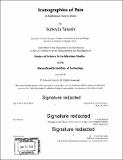Iconographies of pain in Mahmoud Sabri's work
Author(s)
Takesh, Suheyla
DownloadFull printable version (18.55Mb)
Alternative title
Depictions of martyrdom in Mahmoud Sabri's work
Other Contributors
Massachusetts Institute of Technology. Department of Architecture.
Advisor
Nasser Rabbat.
Terms of use
Metadata
Show full item recordAbstract
Out of Iraq's most noteworthy modernist artists, Mahmoud Sabri was perhaps the most attuned to human suffering. Subjects of political martyrdom, social injustice, and the plight of the dispossessed permeate his work throughout the 1950s and 1960s. The period of Iraq's rapid modernization and chaotic political transition from a monarchical regime to a republic in 1958, followed by a Ba'ath military coup in 1963, left the artist with no shortage of tragic events to reflect upon and respond to in his work. His Communist beliefs and a sensitivity to social and economic inequality guided his artistic vision, presenting the world through a lens of human pain caused by political repression. This thesis argues that Sabri's practice in the 1950s and 1960s combined an abhorrence of discrimination with a constant desire to reach the people, especially the working-class, through his art. In light of this, his engagement with Iraqi heritage was not conceived around a formalist or a historicized line of inquiry, but around an exploration of the deep roots of a national identity through popular practices and vernacular customs. As an active contributor to modernist experiments in Baghdad's artistic milieu, Sabri drew from local traditions associated with the notion of martyrdom in the 1950s, which was bolstered by his turning to international iconographies of pain and oppression in the 1960s, to create realist images that condemned injustice exercised by the country's ruling elite. A paradoxical figure in many ways, Sabri combined in his work an interest in the local and the universal, the religious and the secular, in Iraq's past and its political present. Being both a man of the people and a member of the intelligentsia, an Iraqi and a long-time exile, an outspoken supporter of realism and a later convert to abstractionism, Sabri was no stranger to contradiction and internal conflict. What remained consistent in his early practice, however, was a political drive and a heightened sensitivity to the plight of the oppressed, which was layered with a belief that an answer to the predicaments of the disadvantaged could lie in Communism.
Description
Thesis: S.M., Massachusetts Institute of Technology, Department of Architecture, 2018. "June 2018." Cataloged from PDF version of thesis. Includes bibliographical references (pages 76-80).
Date issued
2018Department
Massachusetts Institute of Technology. Department of ArchitecturePublisher
Massachusetts Institute of Technology
Keywords
Architecture.